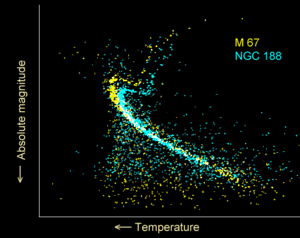Introduction to Astrophysics/Stars/Hertzsprung-Russell
The Hertzsprung-Russell diagram (usually referred to by the abbreviation H-R diagram or HRD, also known as a Colour-Magnitude (CM) diagram) shows the relationship between absolute magnitude, luminosity, stellar classification, and surface temperature of stars. The diagram was created circa 1910 by Ejnar Hertzsprung and Henry Norris Russell, and represented a huge leap forward in understanding stellar evolution, or the 'lives of stars'.
Interpretation
[edit | edit source]
There are two equivalent forms. One is the observer's form which plots the color index of the star on one axis and the absolute magnitude on the other axis. These two quantities can be derived from observations. The theoretician's form plots the temperature of the star on one axis and the luminosity of the star on the other. These two quantities can be calculated from computer models.
The exact transformation from one to the other is not trivial, and depends on the model being used and their parameters (like age and composition). See Sekiguchi and Fukugita, for example, for a transformation between B-V color index and temperature.
The H-R diagram is used to define different types of stars and to match theoretical predictions of stellar evolution using computer models with observations of actual stars.
Most of the stars occupy the region along the line called main sequence. During that stage stars are burning hydrogen. Next concentration of stars is on horizontal branch (helium fusion in the core and hydrogen burning in a shell surrounding the core). Another prominent feature is Hertzsprung gap located in the region between A5 and G0 spectral type and between +1 and -3 absolute magnitudes (i.e. between the top of main sequence and the giant stars in the horizontal branch). RR Lyrae stars can be found in the left of this gap. Hertzsprung gap is a subset of instability strip. In the upper section of instability strip Cepheid variables are residing.
The H-R diagram is also used by scientists to help the figure out roughly how far away the stars are from Earth. This can be done if we know the apparent magnitude we can plot the star onto the graph using its spectral class and the type of star it is. We can then use the graph to deduce the absolute magnitude of the star.
External links
[edit | edit source]